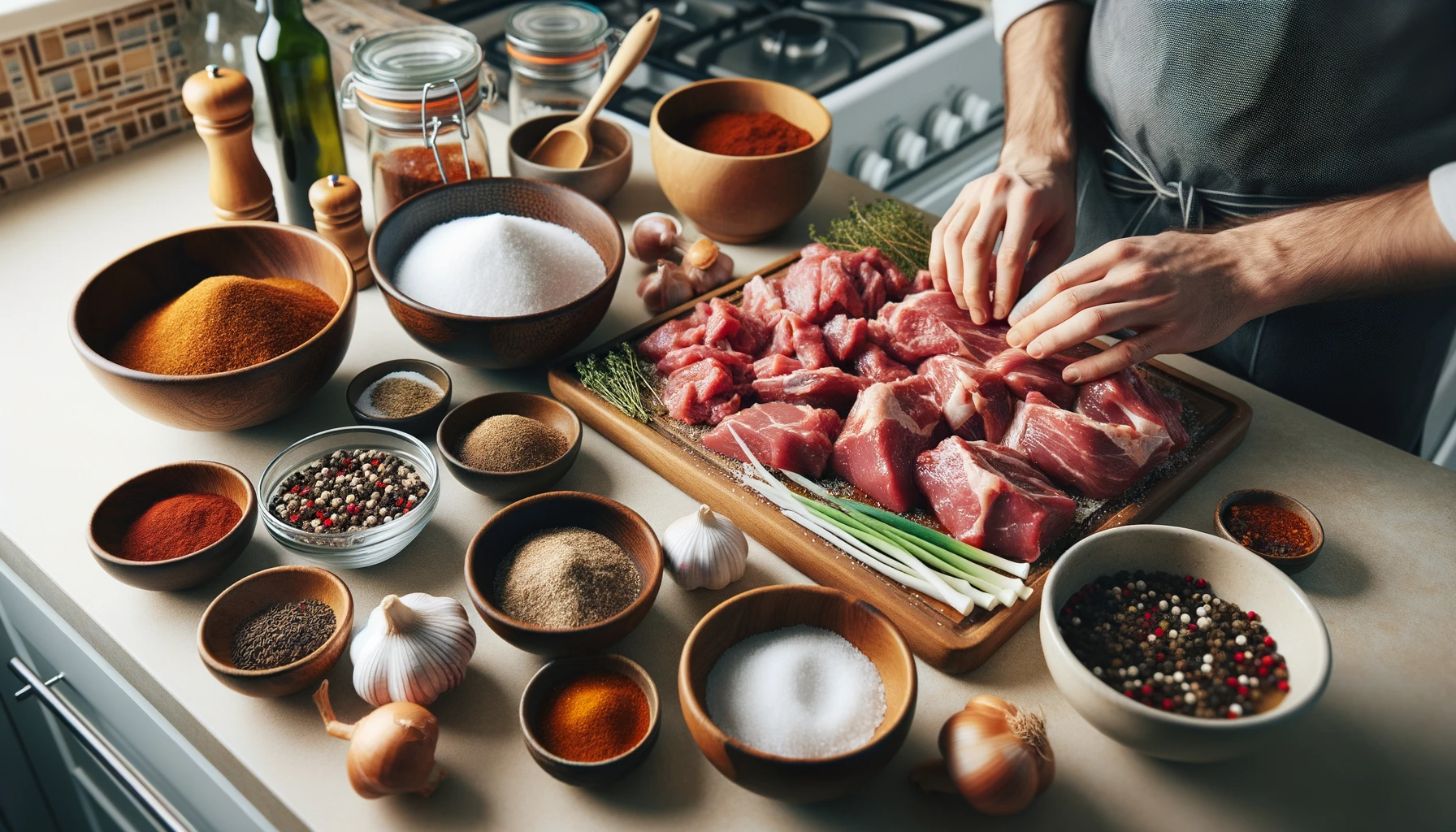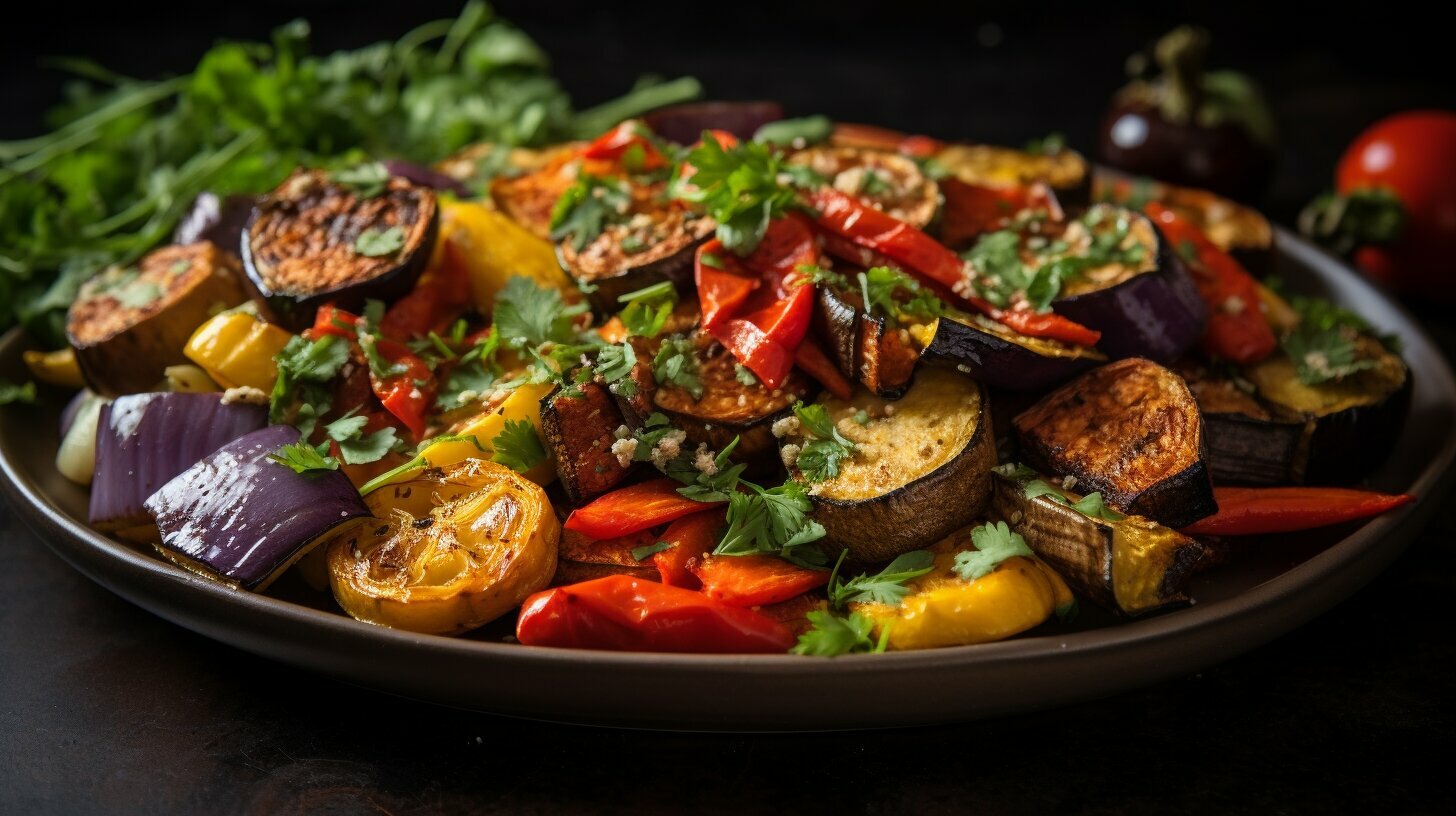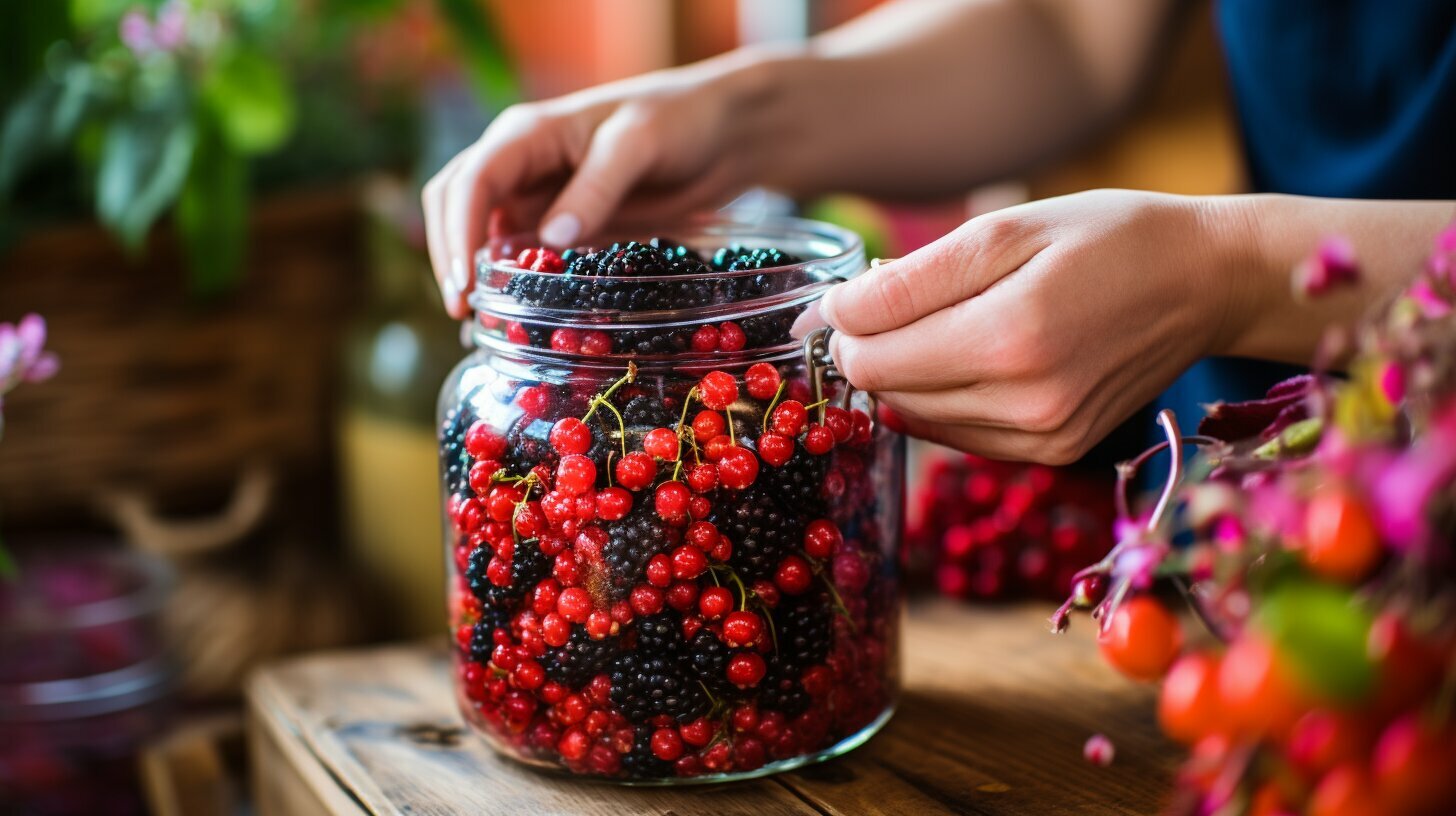Are you tired of constantly buying meat from the grocery store, only to have it spoil before you can use it? Or do you want to explore different curing and aging methods to enhance the flavor of your meats? Regardless of the reason, learning how to preserve meat at home is a practical and rewarding skill to develop.
In this comprehensive guide, we will walk you through various techniques and methods to safely preserve meat at home. From freezing and curing to drying and canning, we’ll cover everything you need to know to ensure long-term meat preservation. So, whether you want to extend the shelf life of fresh meat or create unique, flavorful cured products, we’ve got you covered.
Key Takeaways
- Preserving meat at home is a practical and rewarding skill to develop.
- Various preservation techniques exist, including freezing, curing, drying, canning, salting, pickling, and fermenting.
- The right meat selection is crucial to successful preservation.
- Proper storage is essential for maintaining the quality and safety of preserved meat.
- Hygiene and safety should always be prioritized when preserving meat at home.
Why Preserve Meat?
If you’re interested in meat preservation, it’s essential to understand why it’s a beneficial skill to have. By preserving meat at home, you can enjoy the convenience of having a constant supply of food, regardless of seasonality or availability. Moreover, it allows you to utilize your meat and avoid waste, saving you money in the long run. Additionally, long-term meat preservation can be crucial for emergencies and survival situations.
Preserving meat can be a useful technique for individuals or families who raise their own meat, hunt wild game, or want to take advantage of sales or bulk purchases. By preserving meat at home, you can ensure that the meat stays fresh and doesn’t spoil, extending its shelf life for several months, or in some cases, years.
Disclosure: When you buy through links on our site, we may earn an affiliate commission.
Knowing how to preserve meat at home can also be useful for those who enjoy cooking and want to experiment with different curing and aging methods, creating unique flavors and textures in their meats.
Choosing the Right Meat for Preservation
Choosing the right type of meat is crucial for successful preservation. Here are some tips to consider when selecting meat for preservation:
- Choose fresh meat: Fresh meat is essential for any preservation method. Ensure the meat is of high quality and shows no signs of spoilage.
- Select the right cut: Different meat cuts have varying fat content, which affects preservation. Select fatty cuts for smoking, dry aging, and salting. Leaner cuts are ideal for canning, freezing, and dehydrating.
- Consider the preservation method: Some meat cuts are better suited for specific preservation methods. For example, whole muscles are ideal for dry aging, while ground meat is best for canning.
By following these tips, you can ensure that you select the best cuts of meat for your desired preservation method.
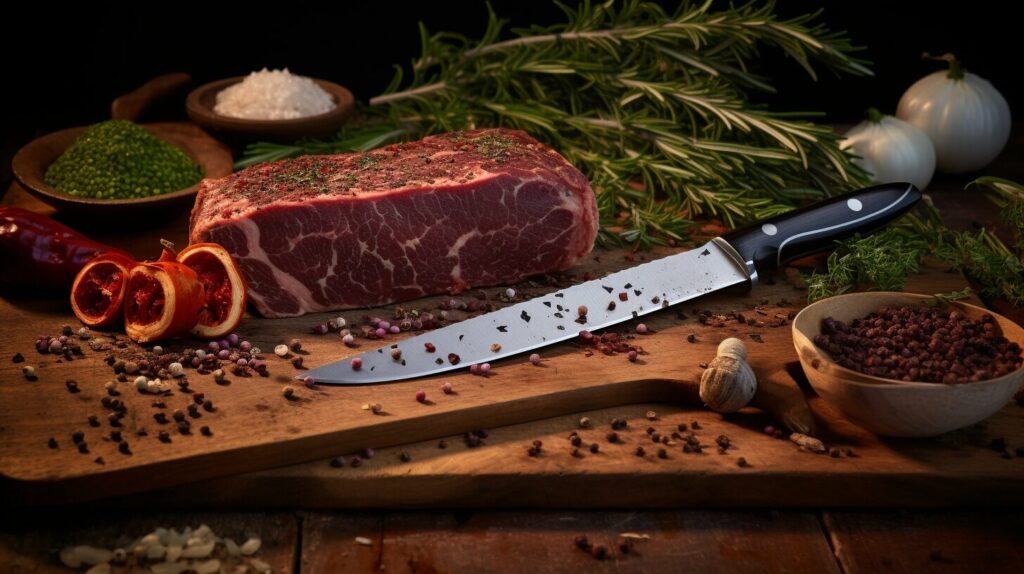
Table: Best Cuts of Meat for Different Preservation Methods
| Preservation Method | Best Cuts of Meat |
|---|---|
| Smoking | Brisket, pork shoulder, bacon, ham |
| Dry Aging | Ribeye, strip loin |
| Canning | Ground beef, stew meat |
| Freezing | Any cut of meat |
| Dehydrating | Lean cuts of beef or game meat |
| Salting | Fatty cuts of pork or beef |
Remember, the quality of your preserved meat depends on the quality of meat you select for preservation.
Freezing as a Preservation Method
Freezing is one of the most popular methods for preserving meat, allowing you to keep your favorite cuts for longer periods. Here are some meat storage tips to help you freeze meat safely and preserve its quality:
- Choose the right packaging: Freezer-safe wrapping materials prevent freezer burn and protect meat from moisture. Plastic wrap, aluminum foil, and freezer bags are all suitable options.
- Label and date: Proper labeling ensures you know what’s in your freezer and when it was stored, helping you use the meat before it loses quality.
- Optimal freezer temperature: Keep your freezer at or below 0 degrees Fahrenheit to maintain meat quality and prevent bacterial growth.
- Recommended storage duration: While frozen meat can last indefinitely, it’s best to use it within 6-12 months for maximum quality.
If you’re looking for the best methods for preserving meat using freezing, here are a few tips:
- Flash freezing: Cut meat into smaller portions and place them on a baking sheet lined with parchment paper. Freeze the meat until it’s firm, then transfer it to freezer bags or containers.
- Vacuum sealing: Vacuum sealing removes all air from the packaging, preventing freezer burn and extending storage duration.
- Pre-cooking: Cook meat partially before freezing it, then finish cooking it later. This technique works well for soups, stews, and other dishes.
- Raw freezing: Freeze meats that you’ll use for raw dishes, such as ground beef, for up to 4 months, and steaks for up to 8 months.
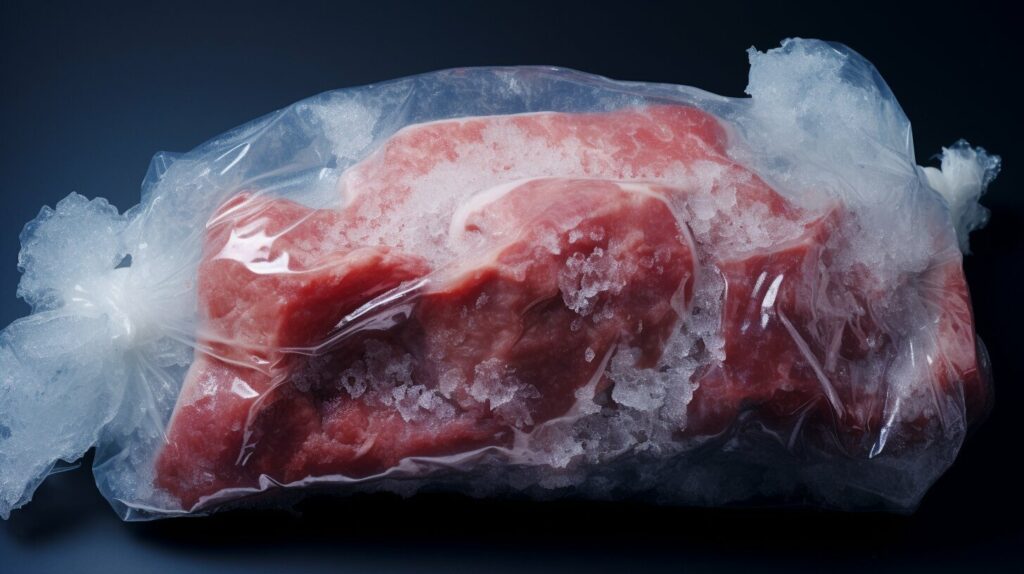
“Proper labeling ensures you know what’s in your freezer and when it was stored, helping you use the meat before it loses quality.”
By following these meat storage tips, freezing can be a reliable long-term preservation method for meat, allowing you to extend its shelf life and avoid wastage.
Curing and Smoking Meat
Preserving meat at home can be an exciting way to explore different meat curing methods. Curing and smoking are popular preservation techniques that add unique flavors and textures to meats.
Curing meat involves adding salt, seasonings, and nitrates to meat, which inhibits bacterial growth and creates a distinctive flavor. Smoking meat not only adds flavor but also exposes meat to heat and smoke, enhancing its preservation qualities.
There are different methods for curing and smoking meat. Here are some popular ones:
Wet Curing
Wet curing involves submerging meat in a brine solution of salt, sugar, and seasonings for a set period. The brine solution can also include nitrates, which help preserve the meat and create a distinct pink color. Wet curing is often used for ham, corned beef, and bacon.
Dry Curing
Dry curing involves rubbing a mixture of salt, sugar, and spices directly onto the meat’s surface. The meat is then wrapped and left to cure for several weeks, allowing it to release moisture and develop flavor. Dry curing is commonly used for salami, prosciutto, and chorizo.
Hot Smoking
Hot smoking involves exposing meat to both heat and smoke, cooking it and preserving it simultaneously. The meat is smoked at temperatures between 165 to 185 degrees Fahrenheit until it reaches an internal temperature of 145 degrees Fahrenheit. Hot smoking is ideal for pork, beef, and poultry.
Cold Smoking
Cold smoking involves exposing meat to smoke at temperatures between 68 to 86 degrees Fahrenheit. The heat is not sufficient to cook the meat, but it adds flavor and preserves it over time. Cold smoking is commonly used for fish, cheese, and bacon.
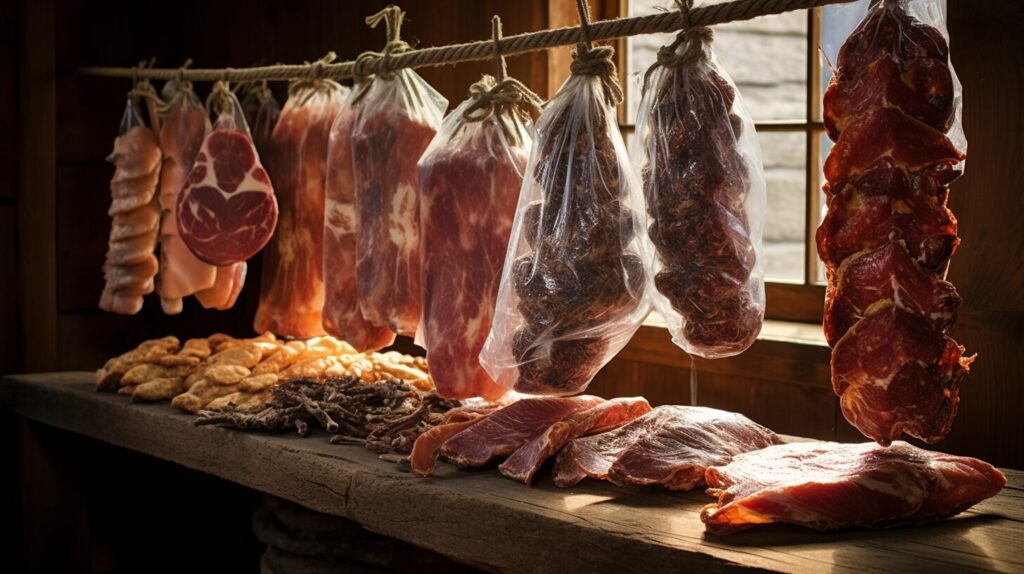
When preserving meat through curing and smoking, it’s critical to prioritize safety. Always use food-grade materials, follow the recommended curing times and temperatures, and ensure proper storage of the preserved meat.
Drying and Dehydrating Meat
Another popular method for preserving meat at home is drying and dehydrating. This process involves removing moisture from the meat, making it an unfavourable environment for bacteria to grow, and extending its shelf life.
There are several different methods for drying and dehydrating meat, including using an oven, dehydrator, or hanging it outside. Whichever method you choose, the steps involved are generally the same.
- Start by selecting the meat you want to dry. Lean cuts of meat like beef or venison work best for this method.
- Cut the meat into thin strips, about a quarter-inch thick.
- If desired, marinade the meat strips in a brine or spice mixture for added flavour.
- Place the meat strips on a rack or tray, leaving space between each piece for air circulation.
- Dry the meat in the oven or dehydrator at a low temperature (around 140°F) for several hours, until it is completely dry and brittle.
- Store the dried meat in an airtight container or vacuum-sealed bag in a cool, dry place.
When drying meat, it’s essential to maintain proper hygiene and food safety practices to ensure the meat doesn’t spoil or become contaminated with harmful bacteria. Use clean utensils and surfaces, wash your hands frequently, and discard any meat that looks or smells off.
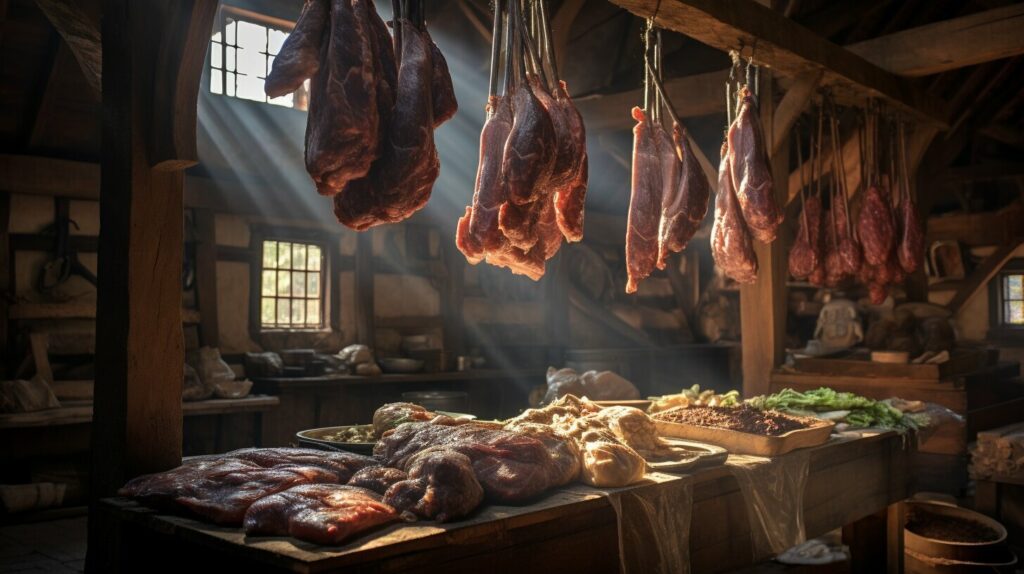
Dried meat is a great option for long-term meat preservation, as it can last for several months or even years if stored correctly. It’s also a lightweight and convenient snack for outdoor activities or travel.
Overall, drying and dehydrating meat is a simple and effective preservation method that anyone can do at home with the right equipment and techniques. Give it a try and enjoy the benefits of this long-lasting meat preservation method.
Canning Meat
Preserving meat at home through canning is a reliable method, especially for long-term storage. The process involves packing cooked meat into jars and heating them to kill any bacteria, creating an airtight seal that prevents spoilage.
To safely can meat at home, you’ll need a pressure canner, jars with lids and bands, and a reliable source of heat. It’s crucial to follow the necessary safety guidelines, including accurately measuring the ingredients, processing the jars for the recommended time and pressure, and checking for any signs of spoilage before consuming.
When canning meat, it’s important to remember that the quality may not be the same as freshly cooked meat. However, it’s an excellent option for long-term preservation that can provide you with a steady supply of meat when fresh meat may not be available.
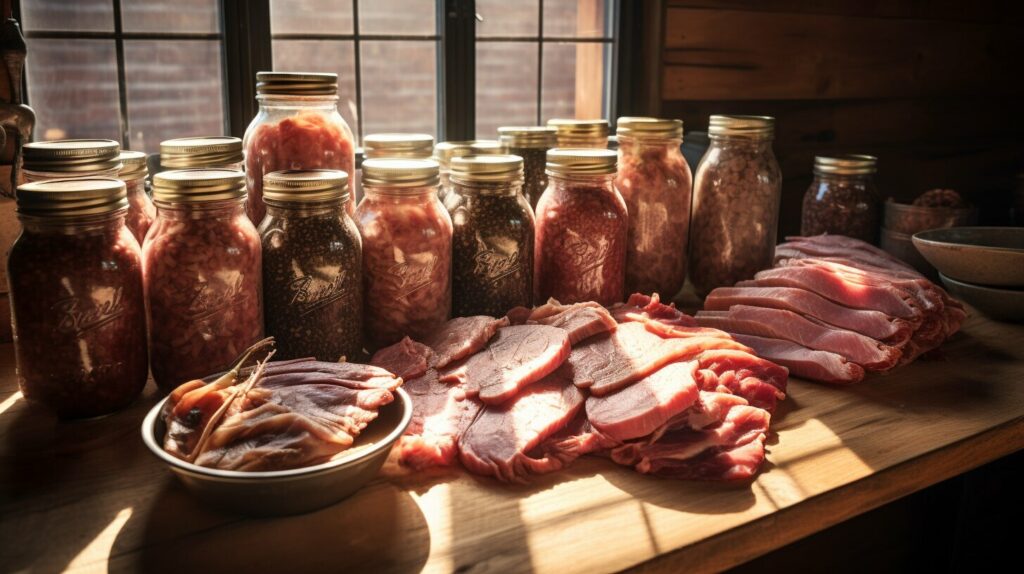
| Meat Type | Processing Time (minutes) | Processing Pressure (PSI) |
|---|---|---|
| Beef, diced or shredded | 90 | 11 |
| Chicken, bone-in or boneless | 75 | 10 |
| Pork, diced or shredded | 75 | 11 |
Source: United States Department of Agriculture
When storing canned meat, keep it in a cool, dry place, away from direct sunlight and moisture. Check the jars regularly for any signs of bulging, leakage, or unusual odors, which may indicate spoilage.
Canning is an excellent method for preserving meat at home, providing a long-term storage option that allows you to enjoy meat throughout the year. With the right equipment and safety precautions, you can safely can a variety of meats for your pantry.
Salting and Pickling Meat
If you’re looking for an alternative to freezing or smoking, salting and pickling meat can be an excellent option for preserving meat at home. Both techniques have been used for centuries as a way to keep meat fresh during long periods without refrigeration.
Salting meat involves coating it with salt and allowing it to dry for several days. The salt draws out the moisture from the meat, thus preventing bacterial growth and spoilage. The salted meat can be stored in a cool, dry place for several months.
Pickling meat, on the other hand, involves soaking the meat in a vinegar solution or brine. The acidic environment of the pickling solution inhibits the growth of bacteria and helps to preserve the meat. Pickled meat can be stored in a cool, dry place for up to a year.
The Benefits of Salting and Pickling Meat
Salting and pickling is an excellent way to preserve meat because it allows you to store the meat for extended periods without refrigeration. It also adds unique flavors to the meat that cannot be achieved with other preservation techniques. Additionally, the preserved meat can be used in various dishes, such as stews, sandwiches, and salads.
How to Salt and Pickle Meat
When salting meat, it’s crucial to use the right amount of salt. Too much salt can result in an overly salty taste, while too little can lead to bacterial growth. The general rule of thumb is to use one pound of salt per five pounds of meat.
To salt meat:
- Cover the meat entirely with a layer of salt.
- Place the meat in a cool, dry place for several days.
- After a few days, remove the excess salt and hang the meat to dry.
- Store the salted meat in a cool, dry place for several months.
To pickle meat:
- Prepare a vinegar solution or brine.
- Soak the meat in the solution for several days, ensuring the meat is entirely covered.
- Remove the meat from the solution and hang it to dry.
- Store the pickled meat in a cool, dry place for up to a year.
Tips for Successful Salting and Pickling
To ensure successful meat preservation, it’s crucial to follow safety guidelines and use the appropriate equipment. Always use food-grade salt and high-quality vinegar when preserving meat. Additionally, keep the meat in a clean and dry environment to prevent contamination.
It’s also essential to choose the right type of meat for salting and pickling. Lean meats such as beef and venison are ideal for salting, while fattier cuts such as pork are better suited for pickling.
Remember, salting and pickling are not the only preservation methods for meat. It’s essential to explore different techniques and find the method that works best for your needs.
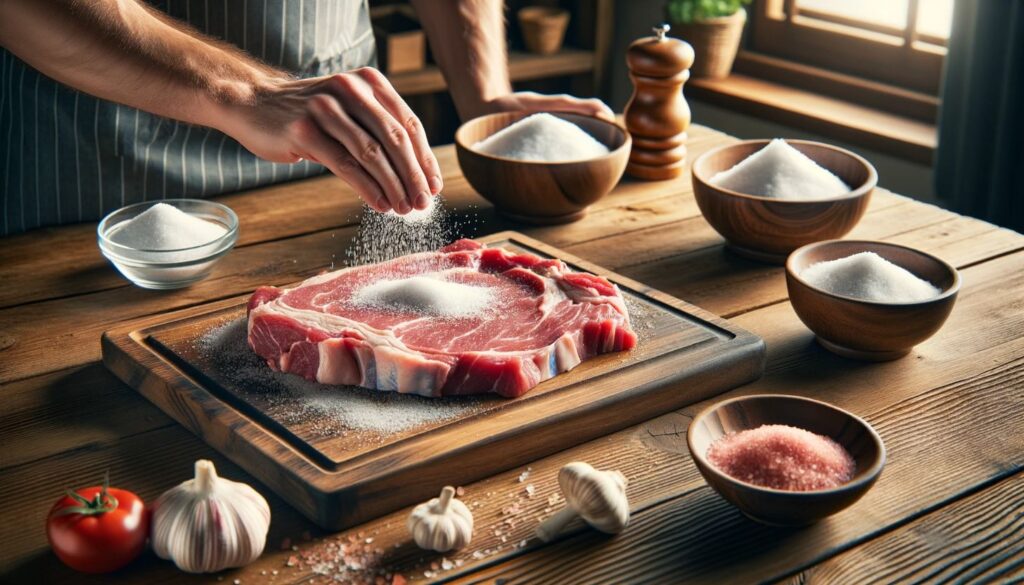
Fermenting Meat
Fermenting meat is one of the oldest preservation techniques, and it involves the use of beneficial bacteria to preserve meats. The process involves breaking down the complex sugars and proteins in meat, creating unique flavor profiles and improving the meat’s texture.
To ferment meat, you’ll need to create an environment that encourages the growth of beneficial bacteria while inhibiting the growth of harmful microbes. This can be achieved by controlling humidity and temperature and using starter cultures that contain beneficial bacteria.
To get started with fermenting meat, follow these steps:
- Choose high-quality meat, preferably with a high-fat content, as this will provide a better texture and flavor after fermentation.
- Prepare the meat by cutting it into small pieces or grinding it.
- Add a starter culture to the meat mixture. Starter cultures contain beneficial bacteria that will break down the meat’s proteins and sugars.
- Place the meat mixture in an airtight container and allow it to ferment at a temperature between 60°F to 75°F for several days.
- Check the meat regularly for signs of spoilage, such as a foul odor or mold growth.
Once the fermenting process is complete, you can store the meat in the refrigerator or freezer for long-term preservation. Fermented meat has a tangy and slightly sour flavor, making it a popular delicacy in many cultures.
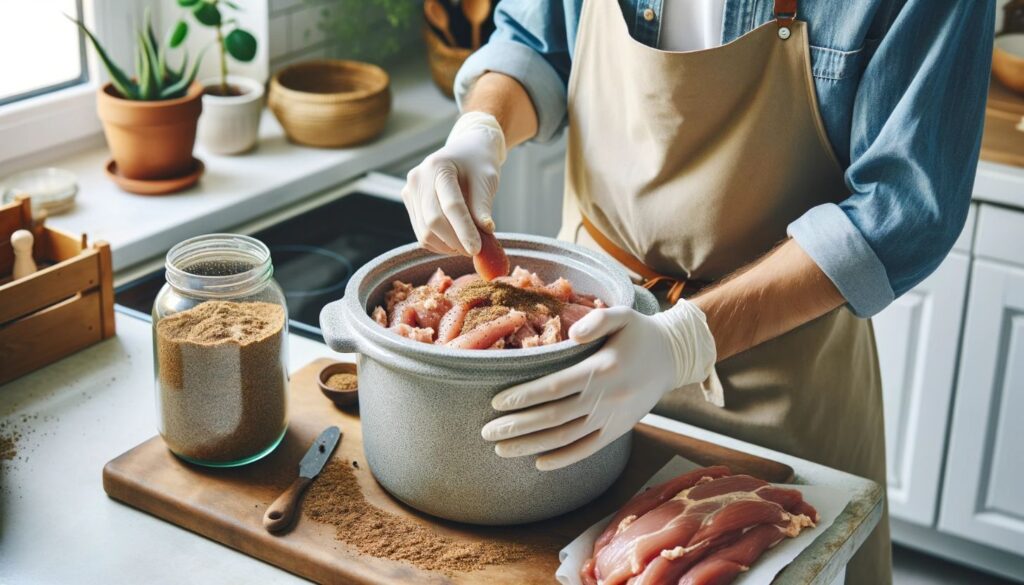
“Fermenting meat is a traditional preservation method that’s been used for centuries, and it’s gaining popularity among food enthusiasts and chefs alike.”
Dry Aging Meat Techniques
Dry aging is a method used to enhance the flavor and tenderness of meat, making it a popular preservation technique for beef. The process involves hanging cuts of meat in a controlled environment with specific temperature and humidity levels, allowing natural enzymes and bacteria to break down the meat’s connective tissues, creating a more tender texture and a unique flavor profile.
To dry age meat at home, follow these steps:
- Choose a cut of meat with a significant amount of fat for better results. Ribeye, striploin, and sirloin are popular choices for dry aging.
- Make sure the meat is fresh and has not been previously frozen.
- Clean a refrigerator or a cooler and place a wire rack inside.
- Place the meat on the wire rack and wrap it loosely with cheesecloth or butcher paper.
- Place a tray of salt or baking soda on the bottom of the cooler to absorb excess moisture.
- Keep the refrigeration temperature at 34-38°F (1-3°C) and the humidity at 60-70%. Use a digital thermometer and a hygrometer to monitor the temperature and humidity levels.
- Let the meat age for 14-28 days, depending on the desired flavor and texture. The longer the aging period, the stronger the flavor and the more tender the meat.
- After the aging period, remove the cheesecloth or butcher paper, trim off any dried or discolored parts, and cut the meat into desired portions.
It’s essential to know that dry aging meat also increases the risk of spoilage and foodborne illness, so it’s crucial to follow safety guidelines carefully. Always purchase fresh, high-quality meat and ensure the refrigerator or cooler is clean and sanitized before use. Avoid cross-contamination by not storing other foods with the aging meat. If in doubt, discard the meat.
When done correctly, dry aging produces flavorful and tender meat that’s perfect for grilling or roasting. Consider trying this technique for your next special occasion or cookout.
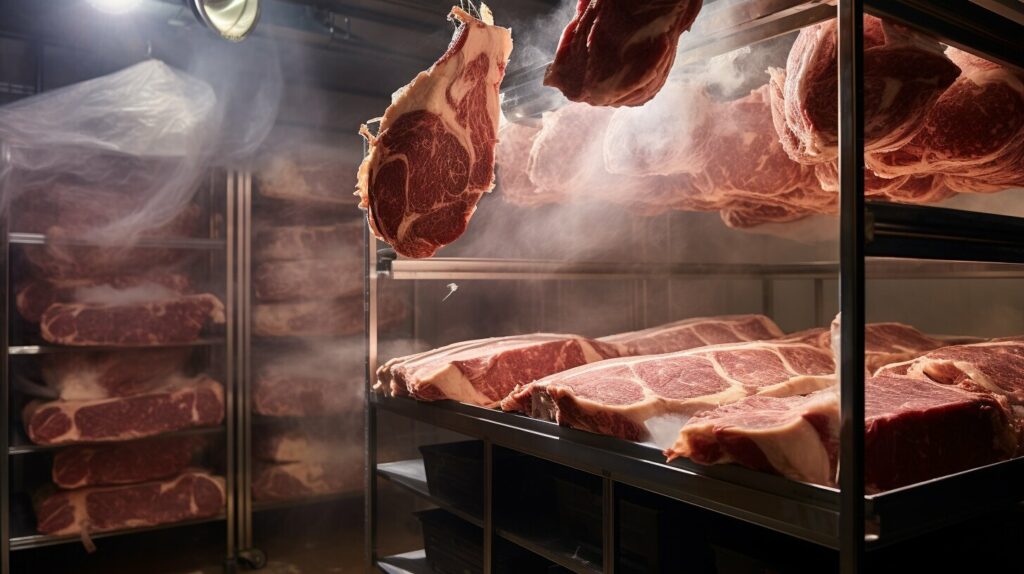
Storing Preserved Meat
Proper storage is crucial to ensure that your preserved meat stays fresh and safe for consumption. Here are some meat storage tips to keep in mind when storing your preserved meat at home:
- Store your preserved meat in a cool, dry, and dark place. Avoid exposing it to direct sunlight or high temperatures.
- Use airtight containers or vacuum-sealed bags to store your meat to minimize the risk of contamination and freezer burn.
- Label your containers or bags with the type of meat, date of preservation, and recommended shelf life.
- If you’re storing meat in a fridge or freezer, make sure that the temperature is consistently maintained. Fridges should be kept at or below 40°F (4°C), while freezers should be at or below 0°F (-18°C).
It’s also important to note that the shelf life of your preserved meat will vary depending on the preservation method used. For instance, canned meat can last up to five years, while dried meat can last up to six months. Refer to the recommended shelf life for each preservation method to ensure that you consume your preserved meat before it spoils.
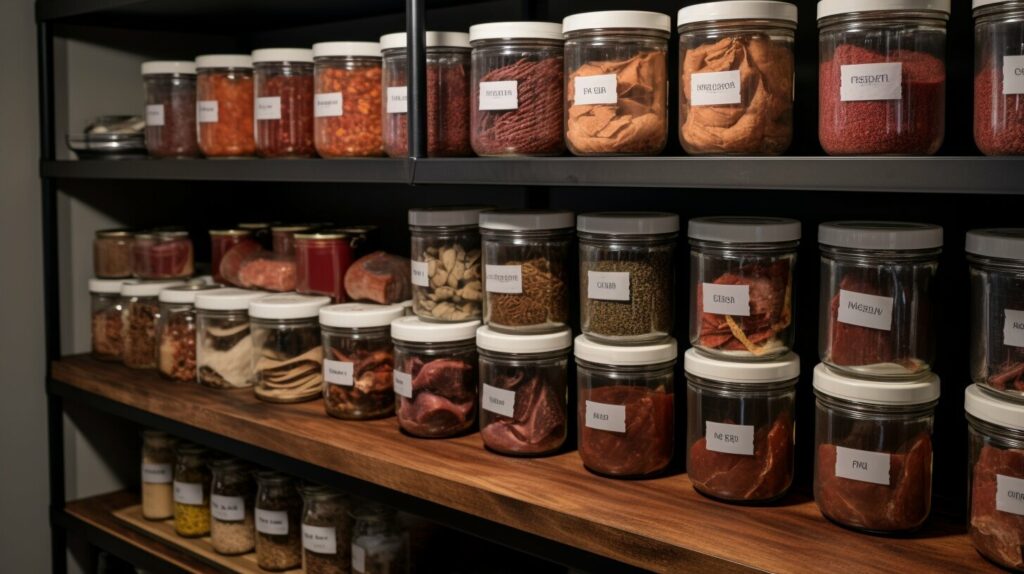
Conclusion
Preserving meat at home allows you to extend the shelf life of fresh cuts and take advantage of seasonal availability or bulk purchases. Techniques like freezing, curing, canning, salting, and fermenting enable safe, long-term storage that provides a steady meat source as needed.
For success, select high-quality fresh meat appropriate for the preservation method. Follow safety guidelines carefully, employ proper sanitization, storage conditions, and usage times. With the right approach, preserving meat can be rewarding and practical, reducing waste, saving money, and ensuring food security. It allows creativity through flavors like smoking and pickling too.
We hope this guide has equipped you with sufficient knowledge to safely preserve meat and unlock the flexibility of enjoying your favorite cuts year-round.
FAQ
Why should I preserve meat at home?
Preserving meat allows you to store it for extended periods, ensuring a constant supply of food. Whether you’re stockpiling for emergencies or simply want to enjoy meats out of season, preservation methods come in handy.
How do I choose the right meat for preservation?
To ensure successful preservation, it’s crucial to choose the right type of meat. Consider factors such as fat content, freshness, and suitability for different preservation techniques.
What is the best method for freezing meat?
Properly freezing meat involves packaging techniques, maintaining optimal freezer temperature, and following recommended storage durations. We’ll guide you through the process.
What are the different methods of curing and smoking meat?
Curing and smoking are traditional preservation techniques that add unique flavors and textures to meats. Learn about different curing methods, such as brining and dry curing, and smoking techniques.
How do I safely dry and dehydrate meat?
Drying and dehydrating meat removes moisture, inhibiting bacterial growth and extending shelf life. We’ll provide step-by-step instructions using an oven, dehydrator, or other equipment.
Can you guide me through the process of canning meat?
Canning is a reliable method for long-term meat preservation. Discover the necessary equipment, safety guidelines, and canning processes to safely store meat in jars.
What is the process of salting and pickling meat?
Salting and pickling are age-old preservation techniques that involve the use of salt or vinegar solutions. Learn how to effectively salt and pickle meat, creating flavorful preserved products.
How does fermenting meat work?
Fermenting meat is a unique preservation method that encourages the growth of beneficial bacteria while inhibiting harmful microbes. Explore the science behind meat fermentation and different fermentation techniques.
What are the techniques for dry aging meat?
Dry aging enhances the flavor and tenderness of meat. We’ll explain the process and provide tips on dry aging meat safely at home.
How should I store preserved meat?
Proper storage conditions, container choices, and recommended shelf life for different preserved meat products are essential to maintaining quality and safety. We’ll discuss the best practices.

